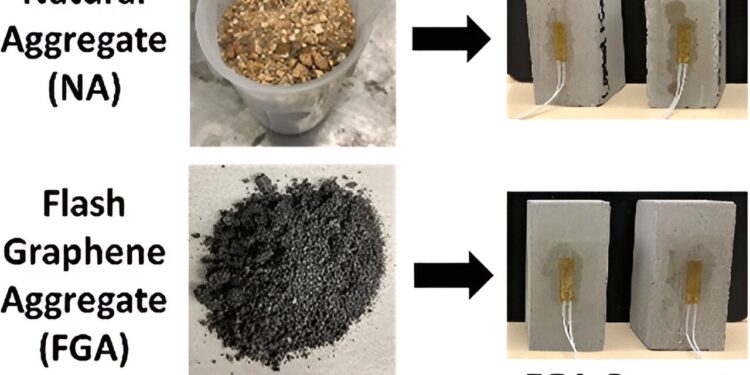Credit: ACS Applied Materials and Interfaces (2023). DOI: 10.1021/acsami.3c15156
Global dependence on concrete, the second most consumed material after water, is leading to an environmental and resource crisis, with rates of sand extraction exceeding those of natural replenishment.
A study by researchers at Rice University published in the journal ACS Applied Materials and Interfaces found that graphene derived from metallurgical coke, a coal-based product, could serve not only as a reinforcing additive in cement, but also as a replacement for sand in concrete.
“This could have a major impact on one of the largest industries in the world,” said James Tour, Rice’s TT and WF Chao Professor and professor of chemistry, materials science and nanoengineering. “We compared concrete made from graphene aggregates with concrete made from appropriate sand aggregates, and found that our concrete is 25% lighter but just as strong.”
Concrete, a mixture of aggregates like sand and gravel bonded with cement and water, is essential to urban development. With 68% of the world’s population living in urban areas by 2050, the demand for concrete and therefore sand mining is expected to increase significantly. This figure has tripled over the past two decades, to around 50 billion tonnes per year. However, this comes at a significant environmental cost.
The production of cement, a key component of concrete, accounts for 8% of global carbon dioxide emissions. Additionally, largely unregulated sand mining poses a serious threat to river and coastal ecosystems. This growing demand for sand, coupled with population growth and urban expansion, could soon trigger a “sand crisis,” according to a 2022 United Nations report.
By applying its Joule heating technique to metallurgical coke, the Tower lab created a type of graphene that could replace sand in concrete.
“Early experiments where metallurgical coke was converted to graphene resulted in a material that appeared similar in size to sand,” said Paul Advincula, a former Rice doctoral student and one of the study’s lead authors. “We decided to explore the use of coke-derived metallurgical graphene to totally replace sand in concrete, and our results show that this would work very well.”
Tests comparing conventional concrete to concrete made from graphene aggregates show promising results. Graphene-based concrete not only matches the mechanical properties of standard concrete, but also offers a higher strength-to-weight ratio.
The Tour lab has used Flash Joule heating for a variety of applications, including the synthesis of hybrid carbon nanomaterials, recycling of battery parts, and the removal of heavy metals from coal fly ash.
“This technique produces graphene faster and on a larger scale than previous methods,” Advincula said.
With the potential to reduce reliance on natural sand and reduce carbon emissions from the concrete industry, this new technology could lead to more sustainable urban development practices.
“It will take some time for the price of graphene to become low enough again to make this viable,” Tour said. “But it just shows that there are alternatives we can pursue.”
Satish Nagarajaiah, professor of civil and environmental engineering and mechanical engineering and corresponding author of the study, pointed out that “30% of concrete is sand, which is a significant portion.”
“The fact that we are on the verge of a ‘sand crisis’ motivates us to look for alternatives, and metallurgical coke, which costs about the same as sand, or about 10% of the price of concrete, could not only contribute to improved quality concrete, but it will also ultimately result in significant savings,” said Nagarajaiah.
More information:
Paul A. Advincula et al, Replacing concrete aggregates with coal-derived flash graphene, ACS Applied Materials and Interfaces (2023). DOI: 10.1021/acsami.3c15156
Provided by Rice University
Quote: Study shows coal-based product could replace sand in concrete (January 26, 2024) retrieved January 26, 2024 from
This document is subject to copyright. Apart from fair use for private study or research purposes, no part may be reproduced without written permission. The content is provided for information only.


